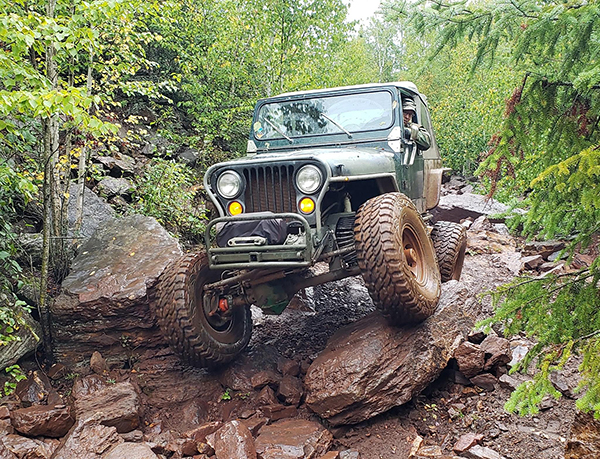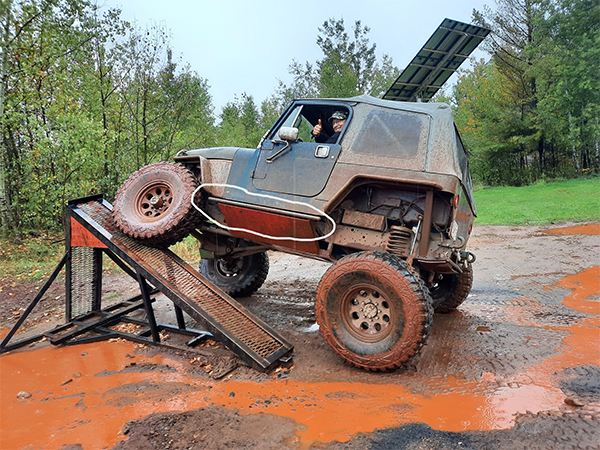
Are you new to the world of off-road trail driving? Maybe you just purchased your first Jeep and now you want to see what all the hype is about. Well then, this is the article for you. I’m going to touch on a few key points and share some tips to get you out there having fun on the road less traveled. I’d like to help take some of the frustrations out of your travels and keep you moving on the trail having a great time. Read along and see if you are aware of these tricks for trail driving.
On Trail Tips
- Airing down – This is simply letting air out of your tires to improve ride quality and traction by increasing the footprint of the tire. There is a bit of an art and science to it, but the short answer is getting your tires aired down to the 10-15 PSI range makes a dramatic difference on how the vehicle rides and how much control you will have off-road. See my article “The Most Profound Off-Road Vehicle Modification!” For more detailed information about airing down your tires.
- Using low range – Four-wheel drive vehicles with a shiftable transfer case have high range and low range positions. Low range provides you with more control off-road because of the gear reduction of the transfer case. It’s like shifting down to a really low 1st gear. Using low range off-road is desirable in almost all driving situations.

- Picking the right line – This is a term you will often hear in the off-road community. It means picking the best path for your vehicle that minimizes the chances of getting your vehicle hung up on trail obstacles. Tip 1, most of the time it is better to drive over obstacles than it is to try to avoid them. Tip 2, the best way to learn this technique is to have an experienced person co-pilot with you and explain what to look for or follow an experienced person driving a vehicle similar in size and tire diameter as what you are driving. Follow the path that they take down the trail. Tip 3, learn your vehicle and how it reacts in different terrain. Note where the low spots are under your vehicle and how to drive to avoid them. See how the vehicle reacts to driving over obstacles. See how it feels driving on side hills and up and down inclines.
- Automatic Transmission driving tips – Tip 1, shift the vehicle down to 1 or 1-2 gear, not D (Drive). Low range gears allow more speed control and some engine braking when descending hills. Tip 2, when crawling through technical areas, add a little throttle with your right foot and control your speed with your left foot on the brake. With some practice, this technique will allow you to crawl over obstacles smoothly. One warning, be mindful of the transmission fluid temperature. Occasionally, give your transmission a break by idling in park. Overheated fluid can cause transmission failure.
- Trail communications – Trail driving is a wonderful way to hang out with friends and meet new people. Who doesn’t enjoy “encouraging” their friends with some lighthearted heckling. Radio communication between vehicles allows you to have fun while you are traveling. Just make sure everyone is using compatible radios. See my article titled “Breaker, Breaker Is There Anyone Out There?” for more information about radio communications.
- Trail Spotter – A trail spotter is someone standing outside the vehicle who can be another set of eyes navigating the trail obstacles. Tip 1, choose the spotter with the most trail experience and and listen to him or her only. Many times, there will be a bunch of people milling around the challenging obstacles and everyone has a different opinion about how to drive over it. Tip 2, keep the driver’s side window down as most trail spotters communicate with a combination of hand and voice signals. If you don’t understand what they are telling you, stop and get clarification before proceeding. Tip 3, sometimes it is best to stop, get out of the vehicle, and walk the trail first before traversing tough areas. It helps you visualize where you need to put your tires for success. Tip 4, the most important tip. The ultimate choice on what line to drive falls on the driver alone. You have the final choice where to drive and who to listen to.
- Trail etiquette – Trail exploration should be able to be enjoyed by everyone in attendance. Here are a couple of tips to ensure that happens. Tip 1, when traveling in groups, always keep the person behind you in sight. If you take a turn, wait at the junction until the person behind you sees where you went. If everyone keeps an eye out for the person behind them, the whole group will continue to travel down the trail smoothly and nobody will be left behind. Tip 2, getting stuck is OK. Part of the fun is to challenge yourself. Most off-roaders are good at helping each other out in a bind. If you are traveling with a group that won’t, pick a different group. Tip 3, learn to be the captain of your vehicle. Keep it maintained and in good working order. Look it over before you get to the trail. Keep some recovery gear, extra clothing, extra food and water with you. Don’t be the guy that is always broken down and unprepared. Most of us work hard all year to be able to get on the trail and wasting time dealing with preventable problems is a good way to sour any relationship. Tip 4, never drink alcohol when trail driving! Save it for the evening campfire. If you can’t wait that long, stay back at the campground.
- Tread lightly – This one is quite simple. Stay on the trail and pick up after yourself. Respect the land and the trail so we and future generations can enjoy this sport for years to come.
Off Trail Tips
- Finding a trail and planning a route – Thankfully this has gotten easier over time. There are some great apps and websites like OnX Off-road, Avenza Maps, Polaris Ride Command, and US Forest Service that allow you to search and area for trails and plan your next trip. My personal go to is OnX because I can search an area, identify trails, see their technical level, and see property owner information. I can plan routes, mark areas of interest, and check out current conditions easily.
- Finding a club – We are fortunate here in Minnesota to have an organization like Minnesota 4 Wheel Drive Association www.MN4WDA.org that works with clubs and businesses to maintain, improve, and expand the trail system here in the state. They are a great source of finding a local club to join. If you live in a different state, see if they have a similar organization and seek them out.
- Attending trail riding events – Organized trail riding events is a great way to meet new people, learn new skills and see some cool equipment. Look for events hosted by clubs, businesses, and groups like MN4WDA for the best experiences.
Vehicle Tips
- Recovery points – Make sure you have a good front and rear recovery points securely mounted to the vehicle frame. The most ideal location is in the center of the vehicle.
- Recovery gear and knowledge – It is important to keep some recovery gear with you if you travel off-road. At a minimum keep a shovel, kinetic energy tow rope, and some shackles in your vehicle. Take some time to learn how to use them properly before you hit the trail. For more detailed information about this subject see my article “Recommended Recovery Equipment for Off-Raod Adventures” .

- Skid plates and rock sliders – Skid plates and rock sliders protect the sides of the body and the underside of the vehicle from damage when traveling on trails with large rocks. Look for some that are properly engineered for your vehicle application.
- Traction aid components – Traction aids usually refer to limited slip, locking, and selectable locking differentials. Most vehicles are factory equipped with open differentials to aid in street drivability. An open differential allows the tires on each axle to spin at different speeds around turns. If off-road conditions the power will be sent to the tire with the least amount of traction. Traction aids lock the tires on each axle together, so they turn at the same speed or near the same speed to help propel the vehicle down the trail.
- Accessorizing your vehicle – The key tip here is lighter is better. Less weight equals more performance and less breakage. It is a balance between building strength and being mindful of unnecessary weight. The Jeep pictured above is about 5700 pounds loaded. In stock form a CJ7 weighs about 3000 pounds. The increased weight is from heavier axles, frame, tires, and roll cage. Just what I needed to make it hold up on the fun trails.
- Vehicle maintenance – Driving off-road trails causes additional wear and tear on your vehicle. Look your vehicle over thoroughly and stay on top of vehicle maintenance. Address known problems before you hit the trail to have the best overall experience while you are out adventuring.
Driving off-road trails can be a fun and rewarding experience. A chance to see some amazing sights that you wouldn’t normally see. It’s a great way to spend some quality time with your friends and family and satisfy your sense of adventure. Grab your favorite four-wheel drive vehicle, some snacks, and a buddy or two and get out there! Enjoy the many trails around the USA, respect them, take care of them, and share them with your friends and family. Make some memories that will last a lifetime and share them around a campfire or two. You won’t regret it!
Aaron Bjorklund